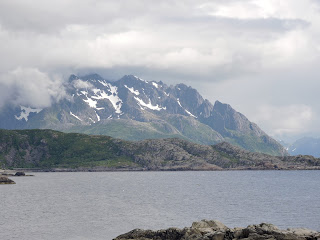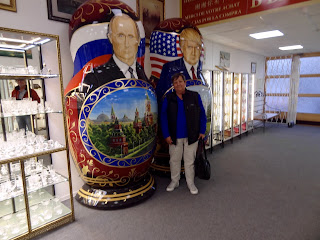June 29 –
After a day at sea and crossing the Arctic Circle around
8:20 PM last night we arrived this morning at Svolvaer in Lofoten, Norway. Lofoten is an archipelago off the
Norwegian coast and Svolvaer is one of the largest cities with a population of
about 5000. The islands lie between 68° and 69° N ; we’re pretty far north!
Despite the latitude, Lofoten has temperatures in the winter which are not as
cold as one would expect. (We’re
talking temperatures in the 5° range versus -47° which were the lows in some of
the fjords we visited earlier.)
This is because of the influence of the Gulf Stream and its extensions, the North Atlantic Current and the Norwegian Current.
The scenery around us was absolutely spectacular. The islands
are a series of irregular peaks
that I can best describe as looking snaggle-toothed. Many are sheer rock; others have significant vegetation and
appear quite lush. I guess it’s
dependent on which way they face and how much sun they get. There was quite a bit of snow on some
of the peaks.
 |
| More of the local scenery |
Not surprisingly the principal industry in these islands is
fishing. Not as much now as in the
past Lofoten was the center of the cod industry. Evidently the waters here have perfect conditions for cod to
spawn. Thus in the winter months the waters are teeming with cod and in years
gone by there would be thousands of boats fishing for them. The process is very interesting. After the fish are caught they are
gutted and the heads are removed from the bodies. All around the islands we could see large wooden racks, some
still with fish on them. The heads
are placed on racks to air dry and freeze (this is all taking place in the dead
of winter.) The bodies are placed
on separate racks for the same process.
As our guide explained it, this method has been used for hundreds of
years and essentially flash freezes the fish. It becomes very hard and can be kept for up to 10
years. Vikings probably carried
this dried fish with them and it allowed them to make their long voyages. The fish can be rehydrated by soaking
it for a week and changing the water often. We asked why the heads were removed and dried separately. It seems the heads are mainly shipped
to Nigeria where they are used to make some kind of traditional soup.
 |
| Fish on the racks in front, heads on the back ones |
 |
| If you click on the photo you'll see just how many racks are around. These fish will be removed soon because they're all dry. |
 |
| This eagle was waiting for some fresh fish to be caught. Forget the dried stuff. |
Our tour took us from Svolvaer to Henningsvaer, a small
former fishing village. It was
virtually abandoned until a few years ago but has now seen a revival as a
tourist destination. The Norwegian government has an interesting policy for
these islands. They pay an
incentive to people to move from the little villages into the larger
towns. They do this so that
services like medical care and schools will be easier to provide. Of course, that has had a negative
impact on the small places.
Anyway, to get to Henningsvaer we passed some inlets and
bays which evidently have quite a tidal change, as much as 5 meters. To get to the village we had to cross
two one lane bridges. The only
traffic lights on the islands are found on bridges like these. The village is
picturesque with a small harbor and quaint wooden buildings around it. We went into an art gallery displaying
works of a famous artist from the region.
Before going into the gallery we saw a video with stunning photographs
of life on the islands. The
pictures of the boats in angry seas and the people who fish and clean the catch
were so interesting. Looking at the people one could imagine how hard a life it
is. The gnarled hands and wind
burned faces were like those of working watermen everywhere, even on Virginia’s
Eastern Shore. Our visit was short
and we were back to the tender dock within a couple of hours.
 |
| Harbor at Henningsvaer |
The ship sailed shortly and we were off for the highlight of
the day. Because we had very calm
winds and brilliant sunshine the captain was able to take us into a place
called Trollfjord. Trollfjord is
an inlet whose mouth is only about 320 feet wide; it widens to a maximum of
2600 feet, enabling us to turn around. It’s only a little over a mile long but
it is stunningly beautiful. Mountains
that are 2000 to 3500 feet high in nearly vertical walls surround the fjord. Our ship is about the largest which is
able to go in and spin around so that we could see this incredible place. We sat on our veranda and took it all
in.
 |
| Entrance to Trollfjord |
After we made our exit we headed north again through smooth
seas on our way to Tromsø. We are
in the Land of the Midnight Sun now so there is essentially no sunset or
sunrise. It’s just always
light. We’re going to try to stay
up one night to see the sun at midnight.
That’s all from Lofoten.











































